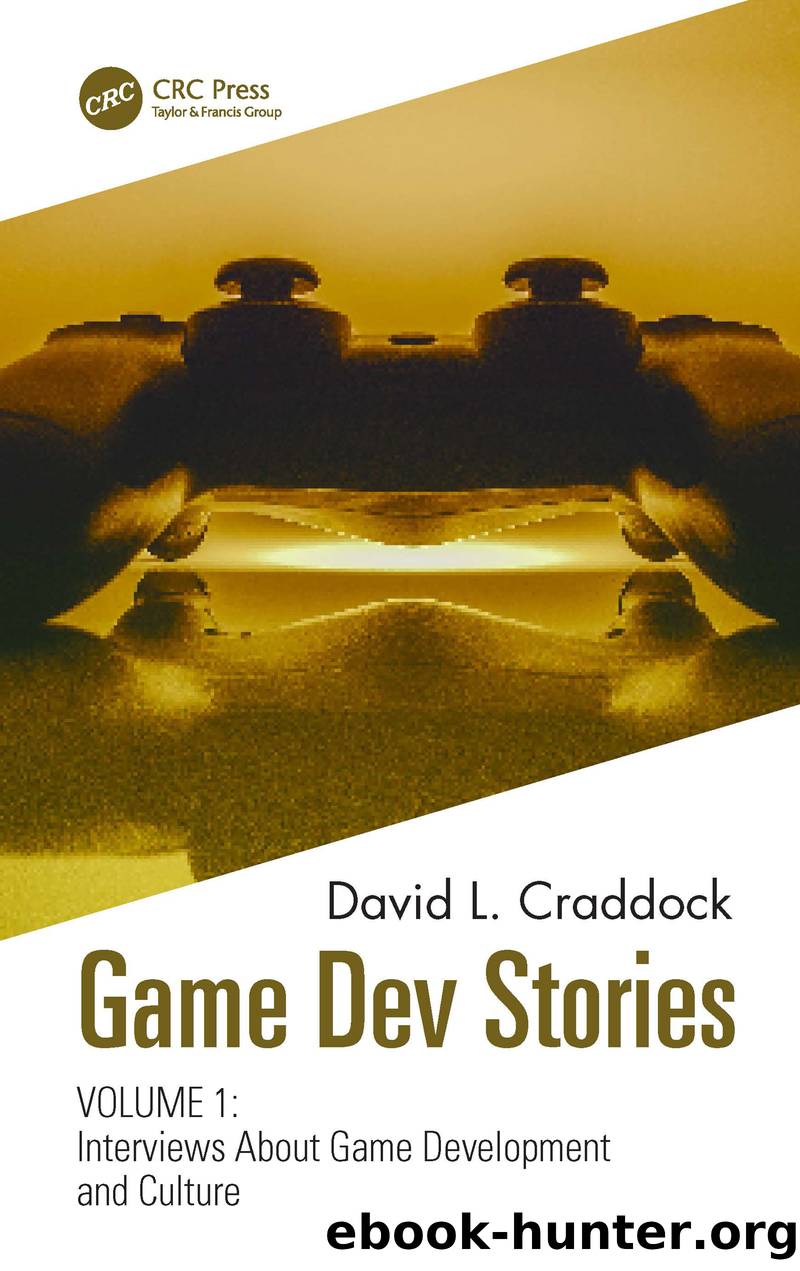Game Dev Stories Volume 1 by Craddock David L.;

Author:Craddock, David L.; [Craddock, David L.]
Language: eng
Format: epub
Publisher: Taylor & Francis Group
Published: 2021-06-30T13:04:21+00:00
6
John Romero
Apple II, id Software, and First-Person Shooters
Over 10 years before John Romero and his cohorts at id Software created Wolfenstein 3-D, Doom, and Quake on IBM PCs, Romero wrote and sold his first commercial games on Appleâs pioneering machine, the Apple II. And even though Apple ceased production of the Apple II family of computers all the way back in 1993, heâs still active in the scene today. He gave the keynote address at the 2012 Kansasfest, an Apple II-centric convention, and as of this writing, heâs hosted three reunion parties where trailblazers from the halcyon days of green screens and dual Disk II drives come face to face and compare notesâoften for the first time.
Over the course of two interviews, Romero talked to me about his earliest experiences as a programmer, the magazines he submitted early games to, and why so many of his peers owe their careers to the Apple II.
**
Craddock:âHow did you become interested in video games?
John Romero:âI used to go to the pinball arcade in Tucson, Arizona, called Spankyâs. It was full of pinball machines on one side, and a snack bar on the other side. After I did that for a while, they started to replace some of the pinball machines with electromechanical games like Dune Buggy. This was around 1974, 1975, around there.
After that, they brought in Pong and Targ, and they got rid of electromechanical once everything was black-and-white video games, like Gun Fight and stuff. That was yellow, but still. [laughs]
I was very excited about video games, and in 1976 I moved up to northern California from Tucson. Around â79, I saw Space Invaders, Tail Gunner, Asteroids, and then in 1980 came Pac-Man. Pac-Man was the one that got me super excited about video games, even though I was already playing them a lot back then. I started programming games in 1979, and in 1980, I decided it was something I had to do [as a career].
Craddock:âWhat was the first computer you learned how to program?
John Romero:âThe first computer I ever used was a terminal connected to an HP9000 mainframe located at Sierra College in Rockwell, California. My friend and my brother came to the house and said, âOh my god, you wonât believe this. We can play video games for free up at the college.â I went, âWhat?!â and I jumped on my bike and we rode our bikes all the way there. This was in the summer of â79.
We got to the college, and it was summer, so there werenât many students there. We went into the computer science building, which was about 60 degrees. There were some students on computers in there, these black-and-white terminals, and I saw they were doing some programming stuff. My friend had access to an account from another friend who lived down the street, so he logged in to that account, and that account had a bunch of games of the time, like Poison Cookie and Hunt the Wumpus.
We were playing those games, and they were very different than video games.
Download
This site does not store any files on its server. We only index and link to content provided by other sites. Please contact the content providers to delete copyright contents if any and email us, we'll remove relevant links or contents immediately.
Technical Art History by Jehane Ragai(405)
Art, Science, and the Natural World in the Ancient Mediterranean, 300 BC to AD 100 by JOSHUA J. THOMAS(382)
Graphic Culture by Lerner Jillian;(372)
The Slavic Myths by Noah Charney(329)
Treasuring the Gaze by Hanneke Grootenboer(305)
Pollak's Arm by Hans von Trotha(303)
Simply Artificial Intelligence by Dorling Kindersley(302)
The Art of Portrait Drawing by Cuong i(295)
Drawing Landscapes by Barrington Barber(290)
Drawing for the Soul by Zoë Ingram(288)
The Art of Painting Sea Life in Watercolor by Maury Aaseng Hailey E. Herrera Louise De Masi and Ronald Pratt(275)
Sketchbook Confidential: Secrets from the private sketches of over 40 master artists by Editors of North Light Books(272)
Portrait of a Woman by Bridget Quinn(260)
Preparing Dinosaurs by Wylie Caitlin Donahue;(255)
A text-book of the history of painting by Van Dyke John Charles 1856-1932(251)
Anatomy for the Artist by Jennifer Crouch(250)
Mountain Manâs Field Guide to Grammar by Gary Spina(249)
Botanical Illustration by Valerie Price(245)
Egyptian art by Jean Capart(244)
